Ouch. This cow is heavily pregnant and about to deliver. Yes, guys, you can't get milk unless a cow first gives birth and produces milk for its baby. That udder looks like it's about to burst (hopefully with life-giving milk, unless the calf has found a way to snuggle there).
So with that image nicely seared in your mind, let's take a look at how milk is produced and processed.
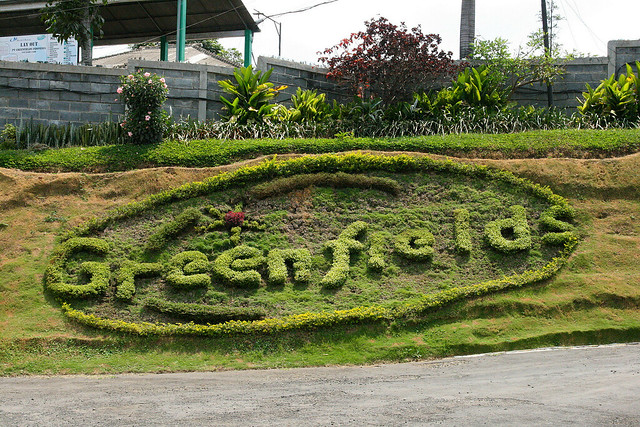
We learned a lot of things on our media familiarisation tour of the Greenfields integrated dairy in Malang, East Java, Indonesia. Things that shattered our perception of "fresh milk" and what really goes on behind the marketing of milk.
I wrote a feature summarising my discoveries about "fresh" milk for Yahoo Makanation:
http://sg.entertainment.yahoo.com/news/truth-fresh-milk-110519384.html
Never mind that so many dairies use additives that make milk less than 100% milk, but did you know "fresh milk" from Australia and New Zealand suffer such long shipping periods that they require double pasteurisation - one time as they leave the dairy, and another as they reach the destination? Yes, because enough bacteria has built up that needs to be destroyed. Nutrients obviously are lost along the way. So what we think are superior "fresh" products from big names might not be all that better.
So distance matters (that's why we don't even get milk from Europe or the U.S. - it just won't survive the trip). For us, Greenfields is one of our nearest dairies. It's kinda next door.
But you must be asking - why would anyone build a dairy in the remote area of Malang, Indonesia?

Firstly, at 1200m above sea levels, the weather is awesome for dairy cows! It's constant all year round (13-24 degrees C). The reason the rest of South-East Asia doesn't have that many dairies is because we are too darn hot and humid. Yes, apparently humans are not the only ones that get grumpy and unproductive at work when it's sweltering. Cows get really stressed out with heat.
Secondly, Malang is actually the second largest town in East Java, and is home to almost 1 million people, with a history dating back to the Mataram Kingdom. It's got surprisingly decent infrastructure, and is close to Surabaya, a major shipping port. Getting your product out quickly mattters when it's something as perishable as milk. From Surabaya to Singapore, it's only 2-3 days by sea (compare that to a week's shipping time from Australia).
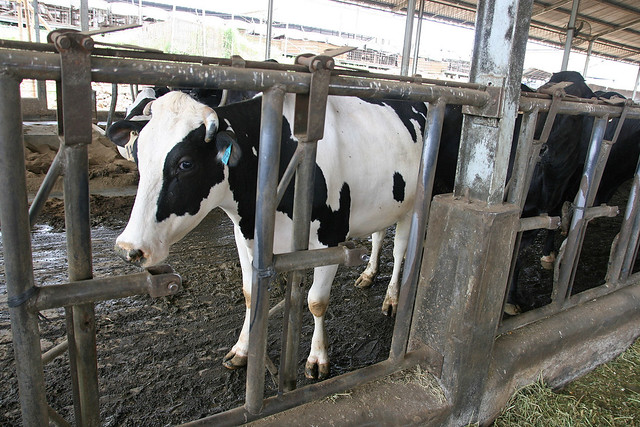
Greenfields is the largest integrated dairy in South-east Asia. By integrated, they mean everything is done in one location - herd management, milking of cattle, processing and packaging. The more milk suffers transportation, the more bacteria are gleefully breaking down the nutrients and enjoying it before you do. Other farms may need tankers to bring the milk to processing plants, but here, it's all done in one place.
The dairy was built in 1997, and is a joint venture between Australian and Indonesian entrepreneurs. Greenfields today produces an average of 20 million litres of fresh milk a year.
They have about 6,000 Friesian Holstein cows. The original stock was brought in from Australia, but most of them are bred locally now using pre-sexed bull semen from the United States. Yes, the semen practically guarantees 90% female cows (XY chromosomes?). After all, only females give milk. Male calves are probably headed for the veal section.
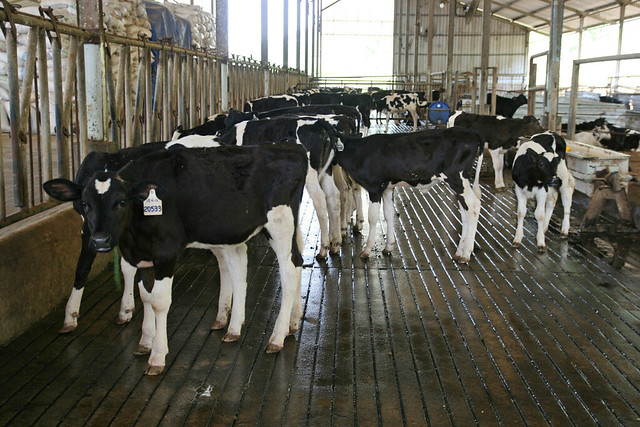
Look at the cute calves in the nursery. It seems almost cruel to deprive them of mommy's milk, but they actually thrive better on special formula. After a few days of essential colostrum from their mother, they are put into a nursery for two months, and then to another holding lot where they will be raised until 12 months.

After 12 months or so, the heifers can start breeding. Cows go through nine months gestation (just like humans). At 24 months, most of them would be milk cows and would have experienced the Maternity ward! The warning sign in red there says, "Do not argue or quarrel in the cattle birthing area" - you don't want the cows in labour even more stressed out!
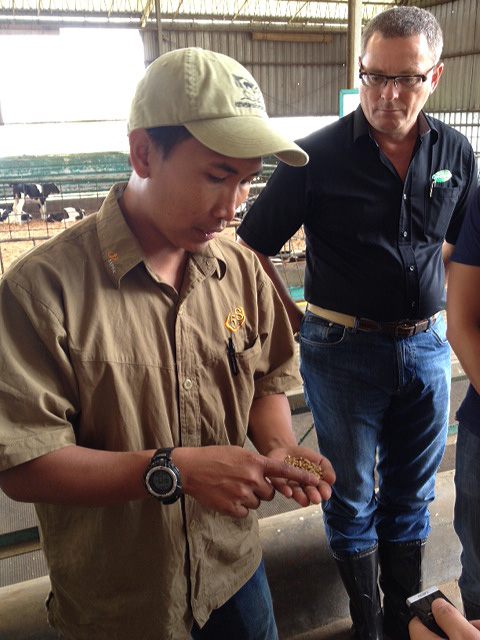
What the cows eat is critical. Here, Jan Gert Vistisen (Head of Marketing and Sales, on the right) and one of his Indonesian staff show us the special compound feed (soy, maize, etc) that's blended to yield optimum milk flavour. The cows also feed on locally sourced king grass, alfafa hay from the U.S. and imported grains. They are fed three times a day, so the feed is kept fresh and cool.
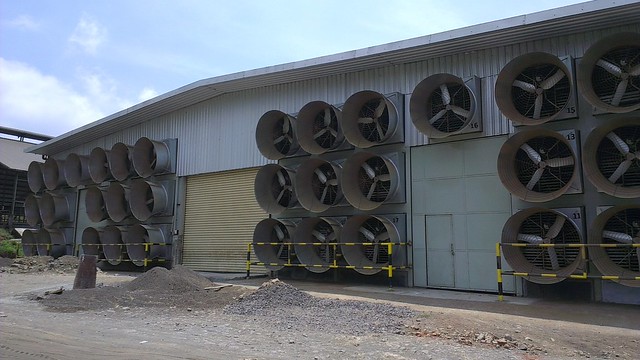
Greenfields is also going one step further with climate deliberate barns. What looks like rocket propellers are huge fans that up the wind chill factor in these hangar-like barns.
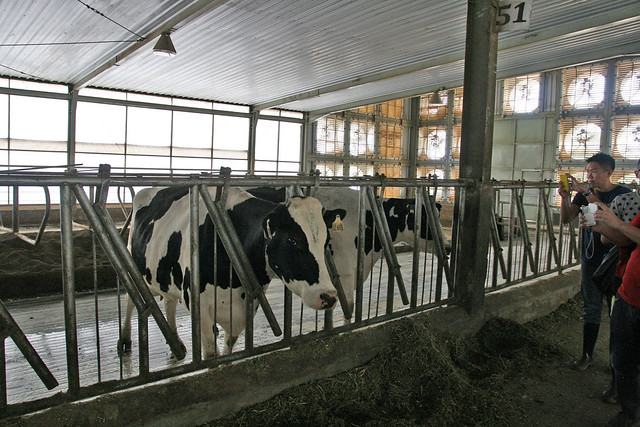
This is what it looks like inside. So the temperature in here is even cooler than outside, resulting in even happier cows. Milk production is up significantly, so it looks like these are a worthy investment.
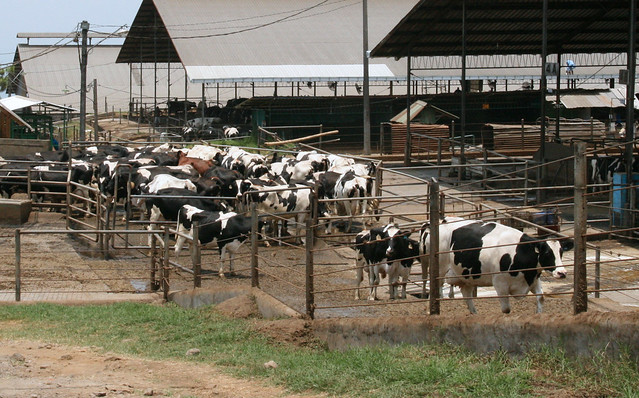
From the barns, the cows make their way to the milking parlour three times a day. While they are being milked, their feedlot and soft sandbeds get cleaned. Then the cows come home, literally. They do this cycle almost automatically, instinctively, obediently, three times a day almost without any prodding. It's amazing how habits can be cultivated like this.
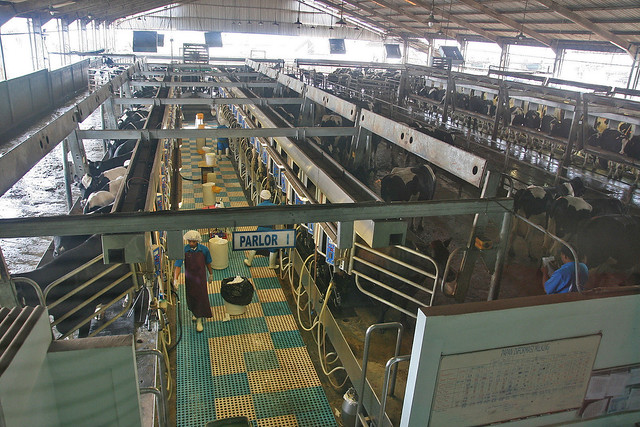
This is the milking parlour. Each cow knows its own place and goes in there automatically. We're all still incredulous.
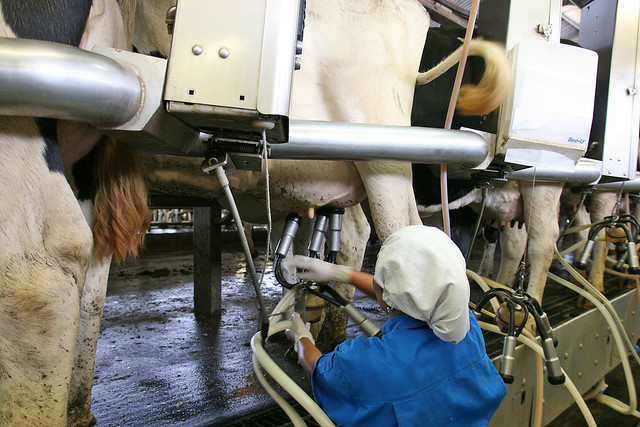
The teats are gently but diligently washed before pumps are attached.
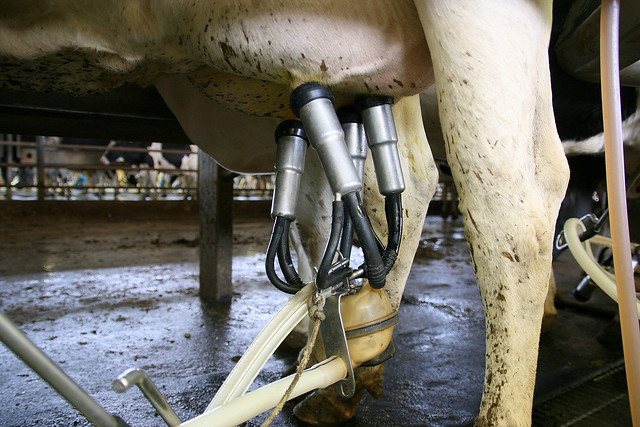
Each cow gets a few minutes milking time, and gives about 30 litres of creamy goodness. The pump has a sensor that detects when milkflow slows down, and automatically detaches from the udder.
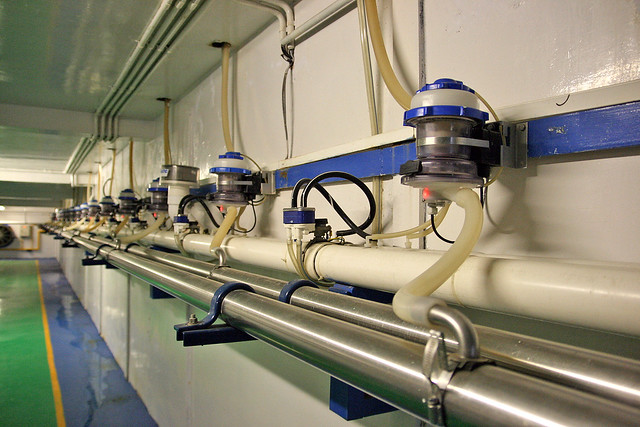
From the pumps, the milk flows to an underground area where the quantity is tracked. The pipes still feel warm, as the freshly extracted milk is the same body temperature as the cows.
It's slightly surreal in here, as it's a sloping room. This is to enable the milk to flow, purely by gravity, to the filtration and cooling room next door. No pumps required, and this means less parts to clean and maintain, and certainly even less human contact. In fact, the whole process is designed that the first time any human touches the milk is when you pop open the seal of the packaging to drink it.

The milk is immediately cooled to 4 degrees C, after impurities are removed. It is then piped to the processing plant which is the next building.
The global codex for raw milk permits a bacteria count maximum of 300,000 cfu/ml before processing at the plant, but with the integrated dairy, Greenfields is able to maintain much lower levels of 8,000-10,000 cfu/ml.
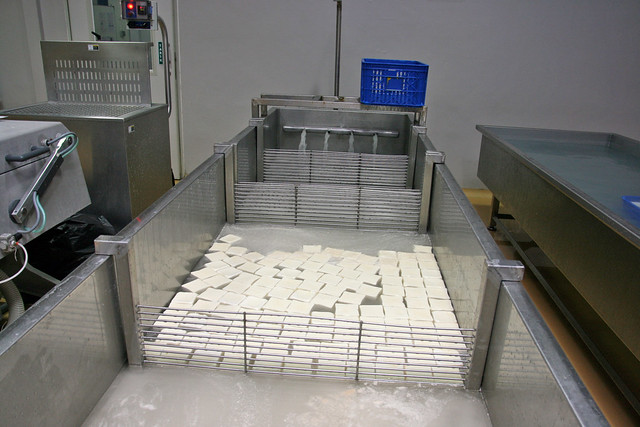
Oh, we got to see how the fresh mozzarella is made. Greenfields had an Italian cheesemaker come and impart his skills to the team here. The fresh milk is pasteurised, and it is churned after culture is added. The solid curds are separated from the whey and then the curd is sliced into strips, and then stretched to produce a delicate consistency - a process known as pasta filata.
Then they are placed into a cheese mould to form large blocks which are then cut into either 200g or 1kg portions. A soak in chilled water and a brine bath later, these tofu-looking blocks are vacuum-packed on the spot and brought to a cool room to sit for two weeks. This allows the cheese to stabilise and reach optimum melting and stretching ability.

Yes, we had to wear all the hygiene protection gear. They don't often allow people traipsing in here.

The processing plant pasteurises and homogenises the fresh milk. It smelled like steaming hot cream in here! Oh, I learned that milk is separated by centrifugal force. Fat is removed to make skim or low fat milk, and the cream is made into whipping cream.
Pasteurisation is at 72 degrees C for 15 seconds to get rid of bacteria without compromising the taste of milk. After pasteurisation, the bacteria count is down to 0-1,000 cfu/ml (the global codex allowance is 30,000 cfu/ml).
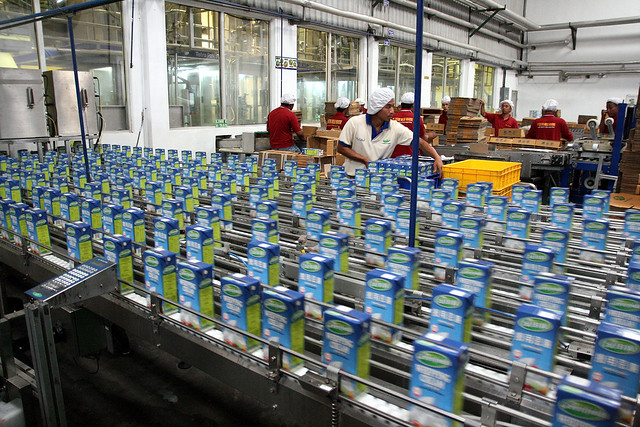
The freshly TETRA-Pak'd products (whipping cream here) comes out to be sorted and packed. Basically, the milk gets packed pretty much within the same day. It then makes its way from the dairy to the port already packaged without any need for further pasteurisation. Greenfields ships products to Singapore, Malaysia, Hong Kong, the Philippines, Myanmar and Cambodia.
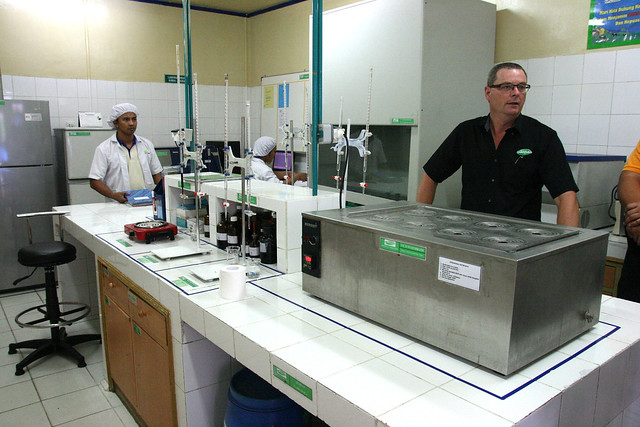
Within the dairy itself is a small research lab where they do quality and safety testing, nutrient analysis and bacteria count.
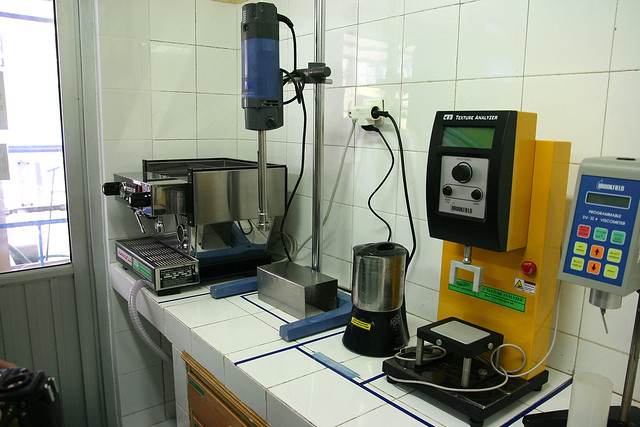
As coffee chains (like Starbucks) make up an important part of their clientele, Greenfields has full fledged coffee-making facilities in the lab too. Milk frothing ability is very important for coffee chains, and it decreases the more bacteria multiplies in the milk.
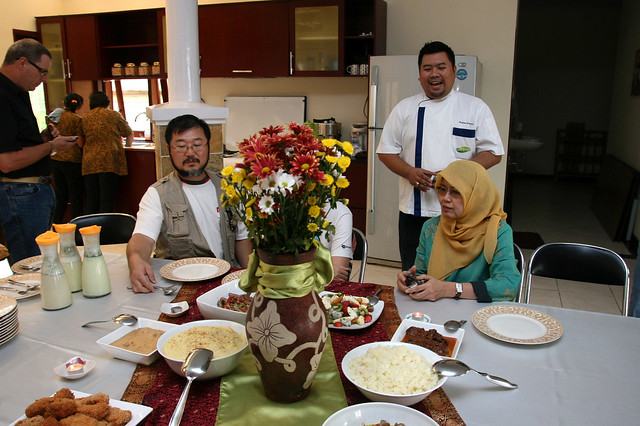
After the we were treated to Chef Fahmi's delectable creations featuring Greenfields products. Chef Fahmi Widarte is their Corporate Chef and is quite well-known in Indonesia. I'm hoping he will develop more recipes to share with us in future.

Dishes from East and West. You can use the milk or cream to replace coconut milk in rendang. The mashed potatoes are extra creamy. And the mozzarella fruit salad is a nifty idea. He also made interesting drinks for us - some minty vanilla thing.
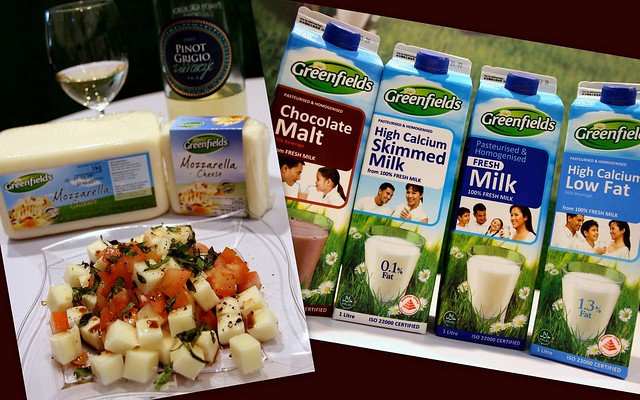
Honestly, I have to admit that when I first came across the brand, I had my reservations about milk made in Indonesia. But my family switched to Greenfields after trying them at FHA 2012, back in April. Back then they had just launched their mozzarella, and the very idea of mozzarella made in Indonesia was bizarre, but after tasting it, I'm quite happy to say I'm glad we have good fresh mozzarella made right next door.
The milk too, tastes very close to what fresh milk ought to. It is one of the very few brands out there that has NO additives. Zero. No preservatives, no hormones, no antibiotics, no milk powder, no permeate/whey, and certainly no colouring. No reconstituted or rehydrated milk. It's just milk.
The only thing that does get added is the chocolate malt flavour - and oh my, it's the best chocolate milk I've tried. Seriously, try it. Someone told me they like it better than Meiji's chocolate milk.
Interestingly, there is no single Asian government standard on what fresh milk is. The AVA doesn't allow skimmed and low fat milk to be called "fresh" milk, but allows it for double-pasteurised milk because it's sanitised. In Hong Kong, the term "fresh milk" is only applicable to single pasteurised milk.
So now when I look at milk, I check the ingredients to see how pure it is, and bear in mind the distance it's traveled.
Go like the GreenfieldsMilkSG on Facebook for updates, news, promos and recipes!

Oh, this is my favourite milk!
ReplyDeleteHi Jyoan, it's my family's current favourite too! :)
DeleteWow, this post is very educational. Thank you!
ReplyDeleteYou're most welcome, Val! I enjoyed sharing this. It was a really good trip.
DeleteMany other low-fat or skimmed milk contain high sugar content, this brand doesn't and I'm so glad to have found it.
ReplyDeleteis the grain or maize you feed your cows produced with GMO?
ReplyDeleteis the grain and maize you feed your cows produced with GMO? where does it come from?
ReplyDeleteI'm also wondering about the grain and maize you feed your cows. Do the cows ever get out to pasture or are they constantly in their "climate-controlled" homes?
ReplyDeleteBtw these guys are just regular bloggers not farm employees lol
DeleteNot sure if you've already got your answer but here goes -
Their webbie : https://greenfieldsdairy.com/business/our-farms/
From the looks of it they're not 'climate controlled', they're open air or room temperature. Weather's probably like something out of a LOTR movie in that region. The herd gets fed crop farmed from the foot of the hills but it's probably not enough so they supplement it with the grains.
You'd have to write them about the GMO part, however I will tell you that GM (and MSG etc) aren't considered that big of a deal to SE Asians because our bodies are a lot tougher than anyone who grows up on a Western diet.. it's really hard to convince us there's a problem when our bodies don't have a problem with it - so most likely yes there'll probably be GM grains once in a while. From the looks of their pictures their feed's a pretty good grass-to-grain ratio though. And reading what goes into the care of the cows - absolutely would not be able to afford to pull that off in Europe or the Commonwealth, would financially ruin the farmers hahaha.
Whether they get to roam - It's a huge integrated compound with some grassy paddocks so I'm guessing they do get to go for a stretch in groups, how often probably depends. But y'know what, the cows look happy, no desperation in their eyes. For me, that's the most important thing. Happy friggin' cows.